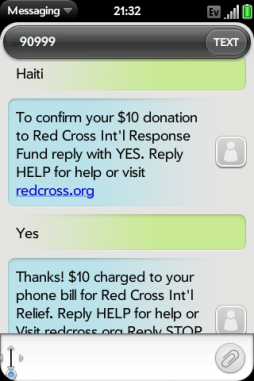Pew Internet Report
Posted by AnneryanHeatwole on Jan 13, 2012
A simple text message can have a big impact. Mobile giving makes it easy to donate almost instantaneously after disaster strikes -- users authorize a mobile donation by texting a keyword to a specific short code, and the donation is then billed to the donor's mobile phone bill, eventually ending up with the nonprofit of choice.
Following the devastating Haitian earthquake of 2010 that left more than 200,000 people dead and more than 1 million Haitians homeless, mobile donations to Haiti totaled more than $43 million -- the first time mobile giving went mainstream in the United States on a large scale.
On the two-year anniversary of the Haitian earthquake, the Pew Internet Project has released "Real Time Charitable Giving," a report that delves into mobile giving and donors' motivations in the U.S.
The report, a collaboration among the Pew Internet Project, the Berkman Center for Internet and Society, the Knight Foundation, and the mGive Foundation, aims to provide a window into the motivations, benefits, and potential pitfalls of mobile giving campaigns.
Drawn from a sample of 863 individuals who made a mobile donation to the "Text for Haiti" campaign, the survey covers why the users gave, how they learned about the mobile donation campaign, how likely they were to share information about their mobile donation, and how likely they were to remain engaged with relief efforts.
| Mobile Donations and Disasters: Lessons from Haiti data sheet 1244 Views |
| Countries: |
Haiti
United States
|
Posted by AnneryanHeatwole on Jan 12, 2012
Real-Time Charitable Giving data sheet 665 Views
Abstract:
Technology is increasingly relevant to Americans’ monetary contributions to the causes and
organizations they support. Previous research from the Pew Research Center’s Internet & American Life Project has found that one in five US adults (20%) have made a charitable contribution online, and that one in ten (9%) have made a charitable contribution using the text messaging feature on their mobile phone. Mobile giving played an especially prominent role during the aftermath of the January 2010 Haiti earthquake, as individual donors contributed an estimated $43 million to the assistance and reconstruction efforts using the text messaging feature on their cell phones.
This new mode of engagement offers opportunities to philanthropies and charitable groups for reaching new donors under new circumstances as messages spread virally through friend networks. At the same time, it poses new challenges, including the uncertainty in fund-raising groups about whether these new donors will remain engaged once they make their donation. In an effort to more fully understand the world of mobile giving, the Pew Internet Project, in partnership with the Berkman Center for Internet & Society at Harvard University and the mGive Foundation, and supported by the John S. and James L. Knight Foundation, conducted the first in-depth study of mobile donors. This report on those who gave to the “Text for Haiti” campaign is based on telephone surveys with 863 individuals who contributed money to the Haiti earthquake efforts using the text messaging feature on their cell phones, and who consented to further communications at the telephone number they used to make their donation.

